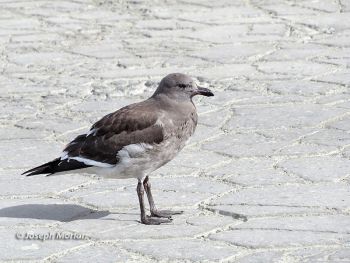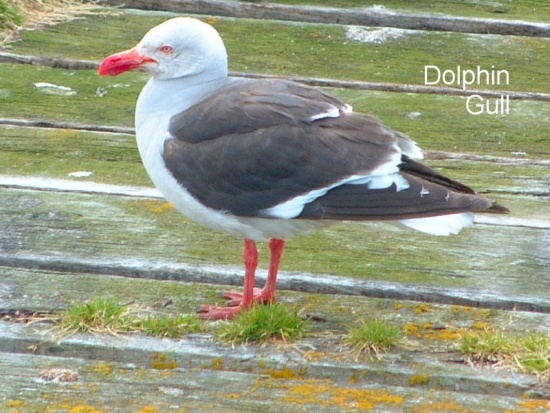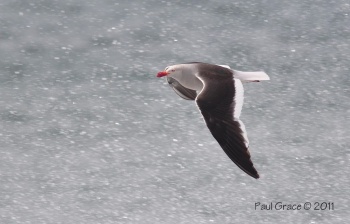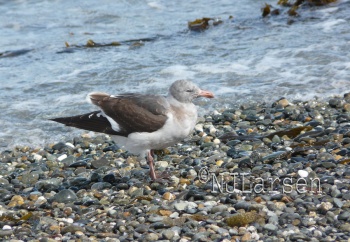Alternative name: Scorseby's Gull
- Leucophaeus scoresbii
Larus scoresbii
Identification
Size: 40–46 cm (15¾-18 in), wing 30.6-33.9 cm, wingspan 104-110 cm, weight 524 g, male generally larger in all measurements.
Adult breeding: Bill and legs red, eye pale surrounded by red ring. Head, neck, and underparts grey, black back and tops of wings with white wing tips. Underwings grey, white tail. In flight shows white trailing edge of wing especially on secondaries and inner primaries.
Non-breeding differs in having dark hood.
Immature: First year with brownish hood, grey neck and upper breast, with rest of underparts and rump white. Black band on white tail. Legs paler reddish than adult, bill pale pink or flesh with dark tip. Second year like adult but with dark hood in summer, bill less bright red, and often with brownish areas on the wing.
Distribution
This handsome small gull is quite common in coastal regions of Southern Chile, Southern Argentina, and the Falkland Islands.
Taxonomy

Photo © by Joseph Morlan
Ushuaia--Barco Hundido, Ushuaia Department, Tierra del Fuego, Argentina, 28 February 2018
This is a monotypic species[4], which is sometimes placed in genus Larus.1,2,3
Habitat
Docks, rubbish piles, mixed with other seabirds on shorelines.
Behaviour
Diet
Their diet consists mostly of offal, with the addition of birds eggs, chicks, aquatic invertebrates.
Breeding
Early November, nest made of kelp and vegetation lined with grass, normally sheltered by boulders or grass. Lays 2-3 olive-buff or grey-green eggs, incubation 24-27 days. Chicks leave nest at 2-5 days.
References
- Dickinson, EC, ed. 2003. The Howard and Moore Complete Checklist of the Birds of the World. 3rd ed., with updates to October 2008 (Corrigenda 8). Princeton: Princeton Univ. Press. ISBN 978-0691117010
- Gill, F and M Wright. 2008. Birds of the World: Recommended English Names. Princeton University Press, Princeton NJ, USA. 2006. ISBN 9780691128276. Update (2008) downloaded from http://worldbirdnames.org/names.html.
- Alvaro Jaramillo. 2003. Birds of Chile. Princeton Field Guides. ISBN 0-691-11740-3
- Clements, J. F., T. S. Schulenberg, M. J. Iliff, D. Roberson, T. A. Fredericks, B. L. Sullivan, and C. L. Wood. 2017. The eBird/Clements checklist of birds of the world: v2017, with updates to August 2017. Downloaded from http://www.birds.cornell.edu/clementschecklist/download/
- Handbook of the Birds of the World Alive (retrieved May 2018)
Recommended Citation
- BirdForum Opus contributors. (2025) Dolphin Gull. In: BirdForum, the forum for wild birds and birding. Retrieved 9 May 2025 from https://www.birdforum.net/opus/Dolphin_Gull
External Links
GSearch checked for 2020 platform.1






